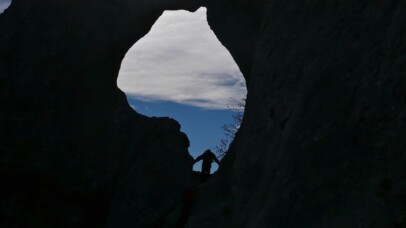Caving
Over 120 caves have been registered in Namibia, the various environments providing plenty of adrenaline-inducing and educative experiences. The longest and only tourist (because of on-site facilities) cave in Namibia is Arnhem Cave, with slightly over 4,800 meters total passage length.
Arnhem Cave is situated in the central region, approximately 130 km’s from Windhoek. The cave is very dusty and dry, with almost no secondary cave formations. Visitors are allowed only torches or cave lamps to negotiate Arnhem’s large chambers and winding passages. Arnhem Cave is still in a completely natural state.
The lack of development causes minimal disturbance of the extensive and diverse bat population, ensuring the conservation of several unique invertebrate species. Six species of bats have been recorded at Arnhem, including the giant leaf-nosed bat. Overnight accommodation is available at the site.
A national monument and the third largest cave in Namibia, the Ghaub Cave in the Otavi Mountains, can be visited on the Ghaub Guest Farm. Guided tours can be organized with a designated guide, miners lamp and safety helmet. The Ghaub cave is 38 meters in depth with 2.5 km of chambers and passageways. Petrified waterfalls, organ pipes, rock curtains and interesting crystal growths are some of the features to be seen.
Dragons Breath, near Tsumeb, is another well-known cave hosting the world’s largest underground lake. Cave diving can be done, but it’s only accessible to professionals and well-equipped cavers.
Another well-visited cave of a different nature is Phillips Cave in the Erongo Mountains north of Karibib. It contains a famous rock painting of a white elephant and many others. In addition, it is surrounded by an evocative rock formation, called Bulls Party, due to its semblance to a group of conferring bovines.
Permission from the landowners is required to visit other caves in Namibia, whilst visiting certain caves requires official permits. Visitors are recommended to wear industrial dust masks when visiting caves with thick deposits of dry bat guano. Since bats are of great ecological importance, visitors are asked not to disturb them, particularly during the wet season (January-April) when bats are breeding.
Cave disease (histoplasmosis) has not been recorded in any Namibian caves. Therefore, prospective visitors, mainly from countries with histoplasmosis or who visit Namibia after caving in such countries, must ensure that all their equipment is cleaned and sanitized before entering Namibia. Such simple precautions may keep Namibian caves uninfected and safe for casual visitors.


